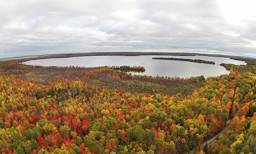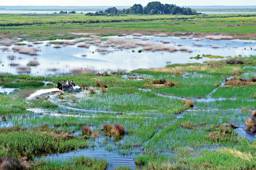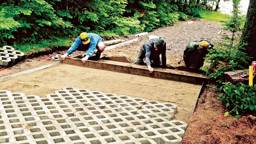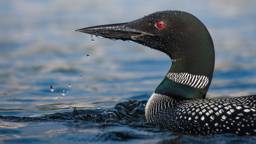People have a remarkable affinity for and attraction to water, so more and more of us are moving to the lake or dreaming about it.
Maybe you have dreamt about a place on the lake for years, and you’ve finally found it. Or you’ve had a place on a lake for years and love it. But you have noted with concern the increasing amount of development that’s happening.
How can you ensure that the lake you love remains beautiful and healthy for generations to come? You can show your love for your lake by incorporating these 10 tips into your lake life.
Maybe you have dreamt about a place on the lake for years, and you’ve finally found it. Or you’ve had a place on a lake for years and love it. But you have noted with concern the increasing amount of development that’s happening.
How can you ensure that the lake you love remains beautiful and healthy for generations to come? You can show your love for your lake by incorporating these 10 tips into your lake life.
1. Buff up the buffer.
A lakeside buffer is a growth of unmowed native vegetation from the shoreline extending to upland areas. Before people started building around lakes, all lakeshores had natural buffers. Some of these natural aspects have been lost, but they can be restored.
Grass mowed down to the edge of the water is not a true buffer. Although it provides groundcover, it is not effective for filtering pollutants in runoff water, and it’s poor wildlife habitat. For a vegetative buffer to be effective, it should span a minimum of 15 feet from shore, but 25 feet or more is recommended.
How does your buffer measure up? If you would like to experiment with a buffer to see what it might look like, leave an area unmowed along the lakeshore and see what grows. There, you’ve done it. You have installed a buffer. You can also modify it in the future by planting other native plants into it.
A lakeside buffer is a growth of unmowed native vegetation from the shoreline extending to upland areas. Before people started building around lakes, all lakeshores had natural buffers. Some of these natural aspects have been lost, but they can be restored.
Grass mowed down to the edge of the water is not a true buffer. Although it provides groundcover, it is not effective for filtering pollutants in runoff water, and it’s poor wildlife habitat. For a vegetative buffer to be effective, it should span a minimum of 15 feet from shore, but 25 feet or more is recommended.
How does your buffer measure up? If you would like to experiment with a buffer to see what it might look like, leave an area unmowed along the lakeshore and see what grows. There, you’ve done it. You have installed a buffer. You can also modify it in the future by planting other native plants into it.
2. Let a fallen tree lie.
Shallow water near the shores of lakes are vital nurseries for all fish species as well as a variety of birds and animals. Practically all fish species rely on nearshore habitat at some point in their life cycle. Walleyes, muskies and other big fish use the area when young for protection and food, and move on later, but small fish species like minnows and darters may use the areas for shelter and food for extended times.
Deadfall – such as a fallen tree in the water – provides great habitat. Studies of undeveloped lakeshores in Michigan found a fallen tree in the water occurred for every six feet of shoreline. What habitat potential! However, at that frequency, what a challenge to get boats in and out and find a swimming space. The key is balance. If a tree falls into the lake and it is not interfering with anything, it’s an instant natural habitat. Maybe it can be left in place. It’s not uncommon for fallen trees to last for 100 years or more. Coarse woody debris can be a natural, long-term habitat resource for your shoreline.
Shallow water near the shores of lakes are vital nurseries for all fish species as well as a variety of birds and animals. Practically all fish species rely on nearshore habitat at some point in their life cycle. Walleyes, muskies and other big fish use the area when young for protection and food, and move on later, but small fish species like minnows and darters may use the areas for shelter and food for extended times.
Deadfall – such as a fallen tree in the water – provides great habitat. Studies of undeveloped lakeshores in Michigan found a fallen tree in the water occurred for every six feet of shoreline. What habitat potential! However, at that frequency, what a challenge to get boats in and out and find a swimming space. The key is balance. If a tree falls into the lake and it is not interfering with anything, it’s an instant natural habitat. Maybe it can be left in place. It’s not uncommon for fallen trees to last for 100 years or more. Coarse woody debris can be a natural, long-term habitat resource for your shoreline.
3. Control exotics.
Historically, there have always been strange animal and plant species invading new territories the world over, getting established and creating problems for the native plants and animals. These days the new invasive species continue to arrive in old-fashioned ways as well as in more modern ways by hitchhiking in a ship’s bilge water or even ordered and delivered over the Internet.
If exotic species are present in your lake, they will be nearly impossible to eradicate. So prevention is the first line of defense against invasive species and is the most economical in the long run.
Is there a prevention plan in place for your lake? Does your lake association mail out information on spotting and controlling exotic plants such as Eurasian watermilfoil or curlyleaf pondweed or exotic creatures like zebra mussels and Asian carp? Are public boat landings on your lake posted with cautionary signs?
Some preventive measures that you can personally employ include:
• Avoid non-native plants (from the Internet or anywhere else). For lists of native plants, try your local county extension office or your state natural resources department.
• Clean your boat hull, motor and trailer thoroughly after removing your boat from a lake, making sure to eliminate all aquatic plant fragments.
• Drain water from live wells, bilges and bait buckets before moving to other waters.
• Dispose properly of unused bait when you complete a fishing trip (give it to other anglers, bury in the garden or put it in the trash).
Historically, there have always been strange animal and plant species invading new territories the world over, getting established and creating problems for the native plants and animals. These days the new invasive species continue to arrive in old-fashioned ways as well as in more modern ways by hitchhiking in a ship’s bilge water or even ordered and delivered over the Internet.
If exotic species are present in your lake, they will be nearly impossible to eradicate. So prevention is the first line of defense against invasive species and is the most economical in the long run.
Is there a prevention plan in place for your lake? Does your lake association mail out information on spotting and controlling exotic plants such as Eurasian watermilfoil or curlyleaf pondweed or exotic creatures like zebra mussels and Asian carp? Are public boat landings on your lake posted with cautionary signs?
Some preventive measures that you can personally employ include:
• Avoid non-native plants (from the Internet or anywhere else). For lists of native plants, try your local county extension office or your state natural resources department.
• Clean your boat hull, motor and trailer thoroughly after removing your boat from a lake, making sure to eliminate all aquatic plant fragments.
• Drain water from live wells, bilges and bait buckets before moving to other waters.
• Dispose properly of unused bait when you complete a fishing trip (give it to other anglers, bury in the garden or put it in the trash).
6. Balance plants and algae.
A battle is always raging in lakes between plants and algae. When plants win, the result is usually clear lake water. You can help the plants win.
Maybe you’ve been working to manage or control exotic plants. Good! But there’s a little word of caution: You will want to protect as many native plants as you can. In fact, in many lakes the challenge becomes to maintain a healthy level of aquatic plants because they use up nutrients that would otherwise feed open water algae.
As a rule of thumb, about 40 percent of a moderately fertile lake should contain aquatic plant growth. At this level, the plants win and the lake should have clear water. Is your lake at the 40 percent threshold? For lakes with good plant coverage, the challenge is to maintain those levels. For lakes that don’t have that coverage, you may want to do a little investigative work to find out what is limiting aquatic plant growth.
For very infertile (low-nutrient) lakes, this 40 percent rule doesn’t really apply. These lakes have so few nutrients that even the low nutrient plant specialists won’t cover 40 percent of the bottom, but the water will still be clear because there are few nutrients to color or cloud the water as well.
A battle is always raging in lakes between plants and algae. When plants win, the result is usually clear lake water. You can help the plants win.
Maybe you’ve been working to manage or control exotic plants. Good! But there’s a little word of caution: You will want to protect as many native plants as you can. In fact, in many lakes the challenge becomes to maintain a healthy level of aquatic plants because they use up nutrients that would otherwise feed open water algae.
As a rule of thumb, about 40 percent of a moderately fertile lake should contain aquatic plant growth. At this level, the plants win and the lake should have clear water. Is your lake at the 40 percent threshold? For lakes with good plant coverage, the challenge is to maintain those levels. For lakes that don’t have that coverage, you may want to do a little investigative work to find out what is limiting aquatic plant growth.
For very infertile (low-nutrient) lakes, this 40 percent rule doesn’t really apply. These lakes have so few nutrients that even the low nutrient plant specialists won’t cover 40 percent of the bottom, but the water will still be clear because there are few nutrients to color or cloud the water as well.
7. Maintain that septic system.
A malfunctioning septic tank system can contaminate nearby drinking water wells and deliver unwanted materials to the lake.
Septic maintenance doesn’t have to be a huge chore. On-site systems are miniature wastewater treatment plants that function almost entirely on their own. We feed them and they do the work, and only minimal maintenance is needed.
The first step in a basic program is knowing where your septic tank and drainfield are. Next you should know how big the tank is and the square footage of the drainfield. It helps to know how old the system is as well. Are all the components up to code or do they need some upgrades? To help answer these questions, you can consult the county records at the local planning and zoning office where you’ll find these vital statistics and more.
The primary maintenance objective with a septic system is to prevent the accumulation of solids from building up in the tank to the point where they leave the tank and enter the drainfield pipes and plug them. Periodic pumping is the key. A rule of thumb: Pump the septic tank every two to three years for permanent residences, with longer intervals for seasonal use. Of course actual accumulation may vary depending on other factors including the number of people using your cabin and whether you operate a dishwasher and washing machine.
A malfunctioning septic tank system can contaminate nearby drinking water wells and deliver unwanted materials to the lake.
Septic maintenance doesn’t have to be a huge chore. On-site systems are miniature wastewater treatment plants that function almost entirely on their own. We feed them and they do the work, and only minimal maintenance is needed.
The first step in a basic program is knowing where your septic tank and drainfield are. Next you should know how big the tank is and the square footage of the drainfield. It helps to know how old the system is as well. Are all the components up to code or do they need some upgrades? To help answer these questions, you can consult the county records at the local planning and zoning office where you’ll find these vital statistics and more.
The primary maintenance objective with a septic system is to prevent the accumulation of solids from building up in the tank to the point where they leave the tank and enter the drainfield pipes and plug them. Periodic pumping is the key. A rule of thumb: Pump the septic tank every two to three years for permanent residences, with longer intervals for seasonal use. Of course actual accumulation may vary depending on other factors including the number of people using your cabin and whether you operate a dishwasher and washing machine.
8. Catch and release.
Why is fishing fun? After considerable debate and much speculation, it turns out there are about 100 reasons. One of the reasons is fish taste good.
Fish are a harvestable and a renewable resource, so we can often keep, clean and cook some of them. However, researchers and anglers have found that large fish are not easily replaceable once they are removed from the lake. It has been proven that the secret to sustained good fishing is maintaining the number of large, breeding fish available for reproduction each year. Besides, it can take 10 years for a largemouth bass to grow to trophy size (10-plus pounds).
That’s where catch and release comes in. While this ethic is widespread now, it’s a relatively recent concept that started picking up steam in the 1970s. Some fish can still be harvested – in fact, a once-in-a-lifetime trophy fish is hard to throw back! And catching an occasional meal is fine. But releasing most large fish back to the lake helps maintain balance through the fish community.
Why is fishing fun? After considerable debate and much speculation, it turns out there are about 100 reasons. One of the reasons is fish taste good.
Fish are a harvestable and a renewable resource, so we can often keep, clean and cook some of them. However, researchers and anglers have found that large fish are not easily replaceable once they are removed from the lake. It has been proven that the secret to sustained good fishing is maintaining the number of large, breeding fish available for reproduction each year. Besides, it can take 10 years for a largemouth bass to grow to trophy size (10-plus pounds).
That’s where catch and release comes in. While this ethic is widespread now, it’s a relatively recent concept that started picking up steam in the 1970s. Some fish can still be harvested – in fact, a once-in-a-lifetime trophy fish is hard to throw back! And catching an occasional meal is fine. But releasing most large fish back to the lake helps maintain balance through the fish community.
9. Keep things in check.
Sometimes just a simple visual checkup can help point you in the right direction. Some examples:
• During a good soaking rain, go out and check the runoff patterns on your lot. Is the runoff going where it should, is it eroding hillside slopes, is there a shed or some other structure intercepting broad overland runoff (aka “sheet flow”), and focusing runoff that is causing erosion? Placing diversions in key places can redirect runoff to avoid potential problems.
• Does water run off your roofs and create rivulets? Consider installing gutters that feed into a rain barrel system, collecting rainwater and feeding it out slowly for infiltration.
• Do you use non-phosphorous detergents? Phosphorous is a nutrient for algae growth, so if a cabin’s grey water contains phosphorous it can fertilize algae blooms in the lake.
• Lastly, are hazardous chemicals stored in a secure, safe place? Even gasoline and oil present potential problems if not handled and stored properly.
The occasional walk-around can help you nip some problems in the bud.
10. Monitor the lake health.
Well, how is the lake doing? Several benchmark tests can be used to gauge lake status and some things can be monitored just for fun.
Monitoring can include a variety of activities ranging from recording ice-on and ice-off dates, to more advanced subjects such as testing for water clarity or for lake nutrient levels.
You never know how these data can be helpful in the future. Water quality data can even be turned in to a state agency for recording. A journal of ice-on and ice-off dates for one Wisconsin lake (about 150 years of continuously recorded data) gave insight to global warming theories.
But more practically, early detection of an incremental problem can be handy. For example, if annual lake water clarity averages decline in one year, it may only be a blip and not a worry. However if your testing shows clarity decreasing for several consecutive years, it may be a trend and then a flag goes up that something is amiss and action can be taken.
Daily journals of wildlife observations and lake phenomena can be a handy reference for the future as well as a fun and valuable family log of cabin life.
So keep a journal, let your shoreline grow au naturel, release the lunkers and fertilize your garden with leftover bait minnows. All these activities can make your lake a little bit better. And if you and your neighbors all take care of your lake, it can be enjoyed by many, many generations to come.
Steve McComas, co-owner of Blue Water Science Consulting Company, is the author of “Lake and Pond Management Guidebook.” Steve also appears on a popular radio show as the “Lake Detective.”
Sometimes just a simple visual checkup can help point you in the right direction. Some examples:
• During a good soaking rain, go out and check the runoff patterns on your lot. Is the runoff going where it should, is it eroding hillside slopes, is there a shed or some other structure intercepting broad overland runoff (aka “sheet flow”), and focusing runoff that is causing erosion? Placing diversions in key places can redirect runoff to avoid potential problems.
• Does water run off your roofs and create rivulets? Consider installing gutters that feed into a rain barrel system, collecting rainwater and feeding it out slowly for infiltration.
• Do you use non-phosphorous detergents? Phosphorous is a nutrient for algae growth, so if a cabin’s grey water contains phosphorous it can fertilize algae blooms in the lake.
• Lastly, are hazardous chemicals stored in a secure, safe place? Even gasoline and oil present potential problems if not handled and stored properly.
The occasional walk-around can help you nip some problems in the bud.
10. Monitor the lake health.
Well, how is the lake doing? Several benchmark tests can be used to gauge lake status and some things can be monitored just for fun.
Monitoring can include a variety of activities ranging from recording ice-on and ice-off dates, to more advanced subjects such as testing for water clarity or for lake nutrient levels.
You never know how these data can be helpful in the future. Water quality data can even be turned in to a state agency for recording. A journal of ice-on and ice-off dates for one Wisconsin lake (about 150 years of continuously recorded data) gave insight to global warming theories.
But more practically, early detection of an incremental problem can be handy. For example, if annual lake water clarity averages decline in one year, it may only be a blip and not a worry. However if your testing shows clarity decreasing for several consecutive years, it may be a trend and then a flag goes up that something is amiss and action can be taken.
Daily journals of wildlife observations and lake phenomena can be a handy reference for the future as well as a fun and valuable family log of cabin life.
So keep a journal, let your shoreline grow au naturel, release the lunkers and fertilize your garden with leftover bait minnows. All these activities can make your lake a little bit better. And if you and your neighbors all take care of your lake, it can be enjoyed by many, many generations to come.
Steve McComas, co-owner of Blue Water Science Consulting Company, is the author of “Lake and Pond Management Guidebook.” Steve also appears on a popular radio show as the “Lake Detective.”
4. Minimize mowed lawns.
Rainwater and snowmelt runoff can deliver clean and pure water to a lake – and that’s a good thing – or it can deliver fertilizer components and sediments – and those are bad things. A healthy groundcover, from cabin to water’s edge, can minimize the introduction of pollutants to your lake. In addition, the vegetation on your lot controls erosion and offers a pleasing setting as well as providing wildlife habitat. What’s the best vegetation to have? Take a look at what occurs naturally in the area and then try to mimic Mother Nature’s work if you can.
There may be areas where lawn is desired. There’s nothing wrong with a bluegrass lawn in a city, but on the lakefront it can be detrimental. Mowed grass is unappealing to frogs and other critters, but alluring to large flocks of geese – which can become real pests. So try to minimize the lawn area near the shoreline.
5. Avoid fertilizing.
A native groundcover should thrive without fertilizer. However if you do use fertilizer, consider using phosphorus-free varieties. Then when rainwater runs off the lawn into the lake, it won’t carry the phosphorus fertilizer with it. Phosphorous is the nutrient that stimulates algae growth in most lakes. If you control phosphorous you control algae.
With a low impact approach to maintaining groundcover, you can use the money you would have spent on fertilizers to buy five new muskie lures or a new mask and snorkel.
Rainwater and snowmelt runoff can deliver clean and pure water to a lake – and that’s a good thing – or it can deliver fertilizer components and sediments – and those are bad things. A healthy groundcover, from cabin to water’s edge, can minimize the introduction of pollutants to your lake. In addition, the vegetation on your lot controls erosion and offers a pleasing setting as well as providing wildlife habitat. What’s the best vegetation to have? Take a look at what occurs naturally in the area and then try to mimic Mother Nature’s work if you can.
There may be areas where lawn is desired. There’s nothing wrong with a bluegrass lawn in a city, but on the lakefront it can be detrimental. Mowed grass is unappealing to frogs and other critters, but alluring to large flocks of geese – which can become real pests. So try to minimize the lawn area near the shoreline.
5. Avoid fertilizing.
A native groundcover should thrive without fertilizer. However if you do use fertilizer, consider using phosphorus-free varieties. Then when rainwater runs off the lawn into the lake, it won’t carry the phosphorus fertilizer with it. Phosphorous is the nutrient that stimulates algae growth in most lakes. If you control phosphorous you control algae.
With a low impact approach to maintaining groundcover, you can use the money you would have spent on fertilizers to buy five new muskie lures or a new mask and snorkel.
 Roger Wade, courtesy Snow Country Construction
Roger Wade, courtesy Snow Country Construction  Cabin Life, Cabin Living
Cabin Life, Cabin Living  Steve McComas
Steve McComas  Cabin Life, Cabin Living
Cabin Life, Cabin Living  Steve McComas
Steve McComas  Steve McComas
Steve McComas  dreamstime.com
dreamstime.com  Steve McComas
Steve McComas  Cabin Life, Cabin Living
Cabin Life, Cabin Living 









